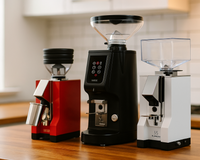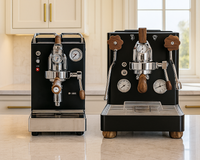Understanding PID Temperature Control in Espresso Machines
Whether you’re just getting started with home espresso or looking to upgrade your current setup, you’ve likely come across the term PID temperature control. It’s a feature touted by many high-end machines, but what does it really mean—and more importantly, is it worth it?
In this guide, we’ll break down what a PID controller is, how it works in espresso machines, and the real-world benefits it brings to your coffee routine. By the end, you’ll know exactly why PID is a game-changer for consistency, temperature stability, and overall brew quality.
What Is a PID Controller?

PID stands for Proportional-Integral-Derivative. It’s an algorithm used in control systems to maintain a desired output—in this case, the temperature of your espresso machine’s boiler(s).
Instead of using a simple thermostat that switches on/off when temperatures fluctuate, a PID controller constantly monitors and adjusts the heat source to keep your brew temperature precisely stable, often within 1°F (or less).
Think of it like cruise control for your boiler. It doesn’t wait for the car to slow down before speeding back up—it proactively keeps things level.
Why Temperature Control Matters for Espresso

Espresso extraction is extremely sensitive to temperature. Even small fluctuations can impact taste:
- Too hot: Over-extracted, bitter espresso
- Too cool: Under-extracted, sour or weak espresso
Without a PID, temperature swings can occur as your machine cycles the heating element on and off. With a PID, those swings are minimized, leading to much more consistent shot quality and easier recipe dialing.
This is especially critical when brewing light or medium roasts, which require precise temperature profiles to extract properly.
Machines That Benefit Most from PID

PIDs are most valuable in machines that offer:
- Single boiler setups where brew and steam temps are managed separately
- Dual boiler machines for independent brew/steam temperature tuning
- E61 group head machines where stability is crucial
Heat exchanger machines (like the Rocket Appartamento) often lack PIDs but can still deliver excellent results. However, newer HX models like the Lelit Mara X feature PID-based thermosyphon control for better temperature consistency.
Benefits of PID Temperature Control

1. Better Shot Consistency
You’ll get more repeatable results, day after day, with fewer off-tasting shots.
2. Easy Temperature Adjustments
Want to fine-tune for a particular roast? PIDs allow you to change brew temps in 1°F increments.
3. Reduced Need for Cooling Flushes
Especially in dual boilers or advanced HX machines, PIDs help maintain the sweet spot without needing long flush routines.
4. Less Temperature Surfing
Older machines require timing your shot to hit the right temp. PIDs eliminate that guesswork.
5. Improved Steam Power (Dual Boilers)
Some machines let you adjust steam boiler temp for more pressure and faster milk steaming.
How Do I Know If a Machine Has PID?
It’s usually noted in the product specs and often visible on the front of the machine as a digital display. Machines with PID will list it as a major feature and may allow you to access a settings menu to adjust temperature and sometimes even boiler priority.
If the machine has no display and relies on a pressurestat, it’s likely not PID-controlled.
Shop all our PID espresso machines >
Best PID Machines (2025)
Lelit Bianca V3
- Dual boiler with dual PID
- Flow control paddle and brew timer
- Precision brewing at its finest
Lelit Elizabeth V3
- Compact dual boiler with PID
- Great for tight spaces
- Fast warm-up and powerful steam
Lelit Mara X
- Heat exchanger with PID-based thermal management
- Ideal for beginners who want E61 performance with better stability
Profitec Pro 700
- Dual boiler with PID and rotary pump
- Commercial-grade performance
Related: Lelit Bianca V3 vs. Profitec Pro 700
Is PID Worth It?
Absolutely—especially if you care about repeatability and exploring different coffees. PID temperature control provides consistency and control that mechanical thermostats simply can’t match. For beginners, it reduces the learning curve. For experienced home baristas, it unlocks precision and potential.
Even if you’re not manually adjusting temperature often, just having stable heat makes brewing easier and more enjoyable.
Final Thoughts
PID temperature control may sound technical, but its benefits are easy to taste. Whether you’re chasing café-level shots at home or simply want to stop wasting beans on bad pulls, PID can be the tool that takes your espresso from good to exceptional.
Need help choosing the right PID machine? Contact our team or explore our lineup of espresso machines to get started.















